Abstract
Background
Maxillofacial injuries are very frequent in the sports environment. Padel is a new sport of Mexican origin, very popular in Mexico, Spain, and Italy, but with a rapid spread in Europe and other continents.
Aims
The aim of this article is to report our experience of 16 patients with maxillofacial injuries that occurred during padel matches in 2021. All these injuries occurred due to the racket bouncing against the glass of the padel court. The bounce of the racquet is given either because the player was trying to hit the ball near the glass or by throwing the racket against the glass for an act of nervousness.
Methods
We carried out a literature review about sports traumas, and we calculated the possible force with which the racket, once bounced off the glass, hits the players’ faces.
Results and Conclusions
The racket, bouncing off the glass wall, arrives with a specific force in the face of the player who threw the racket, being able to cause skin wounds, injuries, and fractures mainly at the level of the dentoalveolar junction.
Keywords: Maxillofacial injuries, Padel game, Dentoalveolar fractures
Introduction
Despite the limited extension of the oral region compared to the whole body, dental and oral injuries account for a fairly high percentage of all body traumas [1–4]. Among head and neck traumas, dental and facial injuries are highly correlated to sports activities.
Padel is a fast-growing racket sport, it’s a combination of tennis and squash and is usually played in pairs using tennis’ rules but is played inside an enclosed synthetic glass and metal court with small dimensions, 10 × 20 meters (Fig. 1). The balls are like tennis balls, but with lower gas pressure. The main characteristic of padel is that the ball can rebound the glass walls, providing an enhanced game rhythm and frequent actions.
Fig. 1.

Depiction of a padel court
Characteristic is the presence of glass walls, these, for the current European legislation, must be made of tempered glass, with a thickness of 10 or 12 mm [2, 4–7].
The glass walls must have an adequate consistency to allow a regular and uniform bounce of the ball. However, this feature also allows the racket to bounce if it hits the wall. The trajectory of the racket, determined by the angle of freedom of the player's elbow, causes the racket to hit the player's face more frequently as it bounces [8].
In recent years, we had to take care of an increasing number of patients with injuries that have occurred in connection with paddle games.
The series comprised 16 patients with facial injuries that occurred during padel matches or training.
The factors considered were age, sex, mechanism of injury, characteristics of the injuries and mode of treatment.
All the patients considered were aged between 15 and 35 years, of these 10 were male and 2 were female. All these injuries occurred due to the racket bouncing against the glass of the padel court. The bounce of the racquet is given either because the player was trying to hit the ball near the glass or by throwing the racket against the glass for an act of nervousness (Fig. 2).
Fig. 2.

Depiction of a racket bouncing against the glass of a padel court
Fortunately, no one of the subjects needed surgical treatment, 3 patients had skin wounds that were treated with sutures, 7 patients had anterior dentoalveolar fractures treated by orthodontic therapy, while 2 patients with skin wounds did not require any type of surgery, only dressings.
We decided to report 5 exemplary cases of the two types of injuries we encountered during these incidents: 3 with skin wounds and 2 with dentoalveolar fractures.
The first patient had a lacerated-contused wound in the supra-ciliary region (Fig. 3), the second patient had a lacerated-contused wound in the upper eyelid region (Fig. 4) and the third patient in the frontal region. These were caused by the impact of the racket bouncing against the glass wall of the padel field because the players threw the racket against the glass for an act of nervousness. The patients were evaluated and CT scans showed no signs of fractures or infractions. It was performed a suture with subsequent clinical re-evaluation 7 days after the accident (Fig. 5).
Fig. 3.
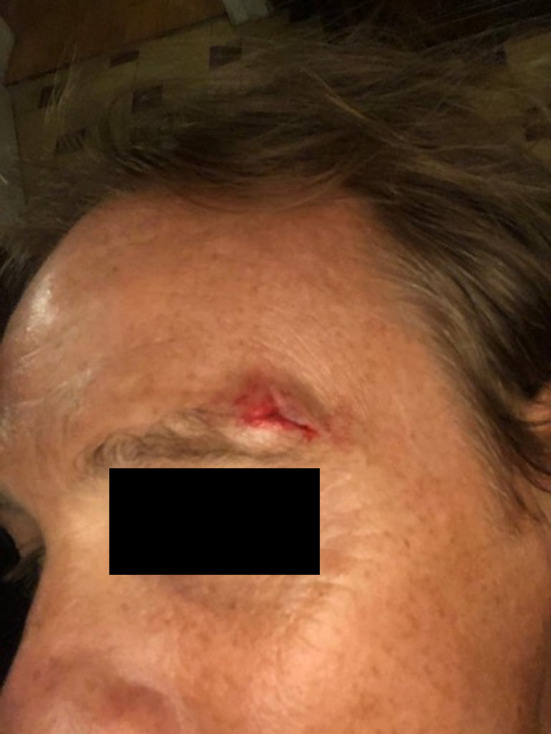
Patient with a lacerated-contused wound in the supra-ciliary region
Fig. 4.
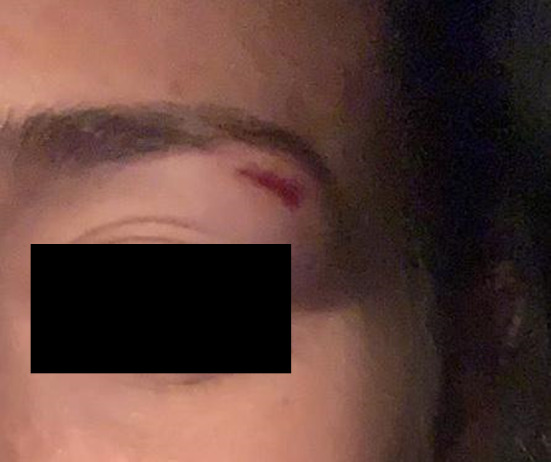
Patient with a lacerated-contused wound in the upper eyelid region
Fig. 5.

Patient with a lacerated-contused wound in the frontal region
The following patients instead had dental-alveolar fractures due to the impact of the racket bouncing against the glass wall of the padel field because the players were trying to hit the ball near the glass. The patients were evaluated and were performed OPTs that showed dental-alveolar fractures, so we opted for orthodontic therapy (Figs. 6, 7).
Fig. 6.
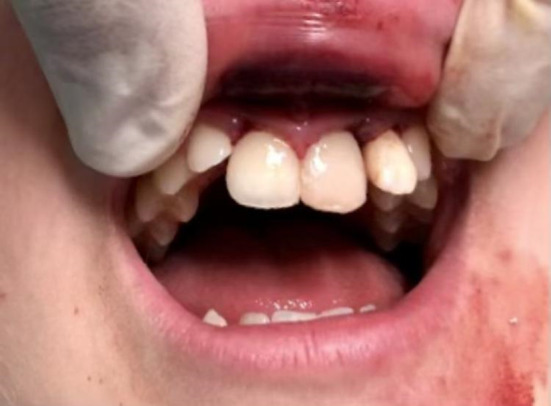
Patient with dental-alveolar fractures
Fig. 7.
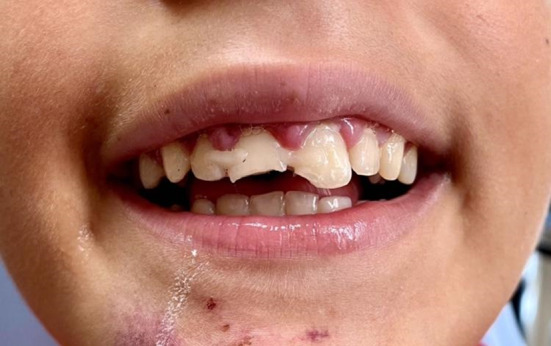
Orthodontic therapy in a patient with dental-alveolar fractures
Materials and Methods
A review was carried out in the literature using the following keywords: sport traumas, sport injuries, padel injuries, padel trauma.
We wanted to calculate the force with which it is plausible that the racket, hitting the face, can cause a fracture. To perform the following calculation in a simplified manner, it has been hypothesized that the impact between the racket and the glass occurred without energy dissipation and therefore after the impact, the racket continued its motion towards the face of the patient with the same speed with which it hit the glass. A one-degree-of-freedom model is analyzed below with the following assumed values:
Natural frequency of the one-degree-of-freedom model (racket-face):
Stiffness of the one-degree-of-freedom model (racket-face): keq = 7273 N/m
Racket’s speed: x˙ = 9 m/s
T/2 = π/λn
Mass of the face: m = 8 kg
In Fig. 8 One-degree-of-freedom model. k1 is racket s stiffness k2 is the stiffness of the face and m is the face of the patient.
Fig. 8.
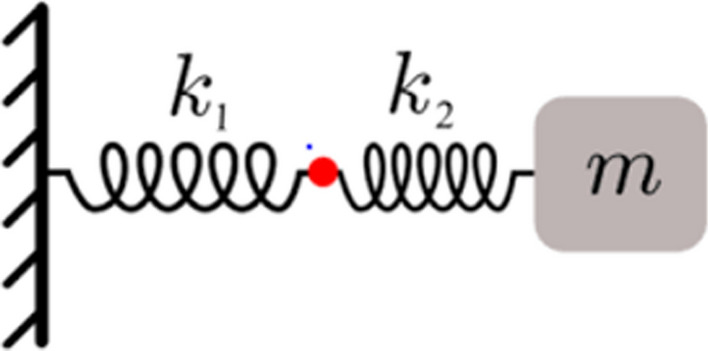
Simplified model of the system
The impulse of the force with which the racket hits the patient’s face is calculated below:
Results and Conclusions
In the last year, there has been an increase in padel-related injuries; however, cases of padel-related maxillofacial injuries have not yet been described in the literature. In our experience, we have noticed the same dynamics underlying these injuries: the racket bouncing against the glass of the padel court and hitting the players’ faces [9–14].
The racket, bouncing off the glass wall, arrives with a specific force in the face of the player, in particular the same force with which initially the racket hit the glass, being able to cause skin wounds or fractures mainly at the level of the dentoalveolar junction.
Funding
The author(s) received no financial support for the research, authorship, and/or publication of this article.
Declarations
Conflict of interest
The authors declare that they have no competing interests.
Footnotes
Publisher's Note
Springer Nature remains neutral with regard to jurisdictional claims in published maps and institutional affiliations.
References
- 1.Gassner R, Ulmer H, Tuli T, Emshoff R. Incidence of oral and maxillofacial skiing injuries due to different injury mechanisms. J Oral Maxillofac Surg Off J Am Assoc Oral Maxillofac Surg. 1999;57:1068–1073. doi: 10.1016/s0278-2391(99)90327-0. [DOI] [PubMed] [Google Scholar]
- 2.Frenguelli A, Ruscito P, Bicciolo G, et al. Head and neck trauma in sporting activities. Review of 208 cases. J Cranio-Maxillo-fac Surg Off Publ Eur Assoc Cranio-Maxillo-fac Surg. 1991;19:178–181. doi: 10.1016/s1010-5182(05)80309-9. [DOI] [PubMed] [Google Scholar]
- 3.Catalfamo LM, Scozzaro C, De Rinaldis D, et al. The C-S approach for the management of median or paramedian frontal sinus lesion. Indian J Otolaryngol Head Neck Surg. 2021 doi: 10.1007/s12070-021-02896-z. [DOI] [PMC free article] [PubMed] [Google Scholar]
- 4.Exadaktylos AK. Sports related maxillofacial injuries: the first maxillofacial trauma database in Switzerland. Br J Sports Med. 2004;38:750–753. doi: 10.1136/bjsm.2003.008581. [DOI] [PMC free article] [PubMed] [Google Scholar]
- 5.Mihalik JP, Myers JB, Sell TC, Anish EJ. Maxillofacial fractures and dental trauma in a high school soccer goalkeeper: a case report. J Athl Train. 2005;40:116–119. [PMC free article] [PubMed] [Google Scholar]
- 6.Hill CM, Burford K, Thomas DW, Martin A. A one-year review of maxillofacial sports injuries treated at an accident and emergency department. Br J Oral Maxillofac Surg. 1998;36:44–47. doi: 10.1016/S0266-4356(98)90747-1. [DOI] [PubMed] [Google Scholar]
- 7.Yamamoto K, Matsusue Y, Horita S, et al. Maxillofacial fractures sustained in bicycle accidents. J Oral Maxillofac Surg Off J Am Assoc Oral Maxillofac Surg. 2011;69:e155–160. doi: 10.1016/j.joms.2010.12.028. [DOI] [PubMed] [Google Scholar]
- 8.(2020) International Padel Federation. Rules of Padel; FIP: Lausanne, Switzerland.
- 9.Escudero-Tena A, Sánchez-Alcaraz BJ, García-Rubio J, Ibáñez SJ. Analysis of game performance indicators during 2015–2019 world padel tour seasons and their influence on match outcome. Int J Environ Res Public Health. 2021;18:4904. doi: 10.3390/ijerph18094904. [DOI] [PMC free article] [PubMed] [Google Scholar]
- 10.Jiménez-Naranjo HV, Coca-Pérez JL, Gutiérrez-Fernández M, Fernández-Portillo A. Determinants of the expenditure done by attendees at a sporting event: The case of World Padel Tour. Eur J Manag Bus Econ. 2016;25:133–141. doi: 10.1016/j.redeen.2016.05.002. [DOI] [Google Scholar]
- 11.Priego Quesada JI, Sanchís Almenara M, Kerr ZY, Alcantara E. Examination of the risk factors associated with injured recreational padel players in Spain. J Sports Med Phys Fitness. 2017 doi: 10.23736/S0022-4707.16.06729-3. [DOI] [PubMed] [Google Scholar]
- 12.Sánchez-Alcaraz BJ, Martínez-Gallego R, Llana S, et al. Ball impact position in recreational male padel players: implications for training and injury management. Int J Environ Res Public Health. 2021;18:435. doi: 10.3390/ijerph18020435. [DOI] [PMC free article] [PubMed] [Google Scholar]
- 13.Sánchez-Alcaraz Martínez BJ, Courel-Ibáñez J, Cañas J. Estructura temporal, movimientos en pista y acciones de juego en pádel: revisión sistemática (Temporal structure, court movements and game actions in padel: a systematic review) Retos. 2017 doi: 10.47197/retos.v0i33.55025. [DOI] [Google Scholar]
- 14.Thörnland C, Jakobsson G. Eye injuries related to padel. Lakartidningen. 2021;118:21001. [PubMed] [Google Scholar]


